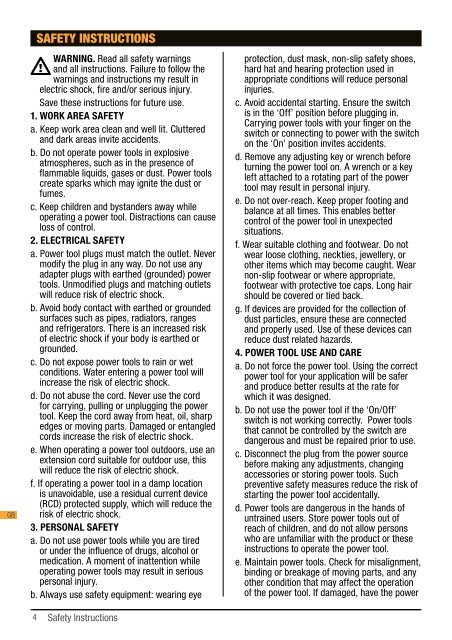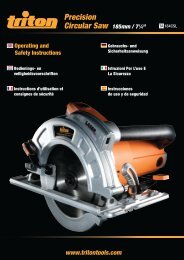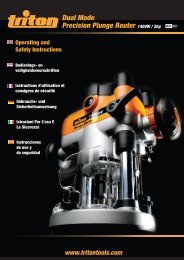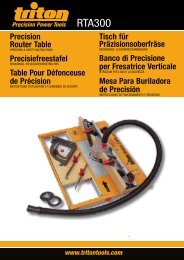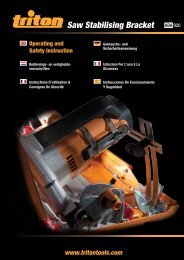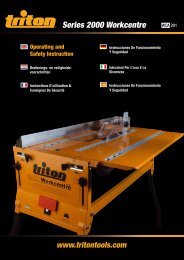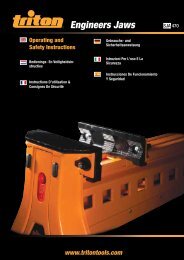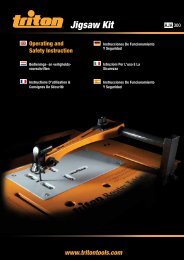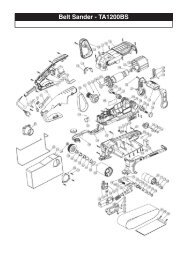Biscuit Joiner - Triton Tools
Biscuit Joiner - Triton Tools
Biscuit Joiner - Triton Tools
Create successful ePaper yourself
Turn your PDF publications into a flip-book with our unique Google optimized e-Paper software.
GB<br />
SAFETY INSTRUCTIONS<br />
WARNING. Read all safety warnings<br />
and all instructions. Failure to follow the<br />
warnings and instructions my result in<br />
electric shock, fire and/or serious injury.<br />
Save these instructions for future use.<br />
1. WORK AREA SAFETY<br />
a. Keep work area clean and well lit. Cluttered<br />
and dark areas invite accidents.<br />
b. Do not operate power tools in explosive<br />
atmospheres, such as in the presence of<br />
flammable liquids, gases or dust. Power tools<br />
create sparks which may ignite the dust or<br />
fumes.<br />
c. Keep children and bystanders away while<br />
operating a power tool. Distractions can cause<br />
loss of control.<br />
2. ELECTRICAL SAFETY<br />
a. Power tool plugs must match the outlet. Never<br />
modify the plug in any way. Do not use any<br />
adapter plugs with earthed (grounded) power<br />
tools. Unmodified plugs and matching outlets<br />
will reduce risk of electric shock.<br />
b. Avoid body contact with earthed or grounded<br />
surfaces such as pipes, radiators, ranges<br />
and refrigerators. There is an increased risk<br />
of electric shock if your body is earthed or<br />
grounded.<br />
c. Do not expose power tools to rain or wet<br />
conditions. Water entering a power tool will<br />
increase the risk of electric shock.<br />
d. Do not abuse the cord. Never use the cord<br />
for carrying, pulling or unplugging the power<br />
tool. Keep the cord away from heat, oil, sharp<br />
edges or moving parts. Damaged or entangled<br />
cords increase the risk of electric shock.<br />
e. When operating a power tool outdoors, use an<br />
extension cord suitable for outdoor use, this<br />
will reduce the risk of electric shock.<br />
f. If operating a power tool in a damp location<br />
is unavoidable, use a residual current device<br />
(RCD) protected supply, which will reduce the<br />
risk of electric shock.<br />
3. PERSONAL SAFETY<br />
a. Do not use power tools while you are tired<br />
or under the influence of drugs, alcohol or<br />
medication. A moment of inattention while<br />
operating power tools may result in serious<br />
personal injury.<br />
b. Always use safety equipment: wearing eye<br />
protection, dust mask, non-slip safety shoes,<br />
hard hat and hearing protection used in<br />
appropriate conditions will reduce personal<br />
injuries.<br />
c. Avoid accidental starting. Ensure the switch<br />
is in the ‘Off’ position before plugging in.<br />
Carrying power tools with your finger on the<br />
switch or connecting to power with the switch<br />
on the ‘On’ position invites accidents.<br />
d. Remove any adjusting key or wrench before<br />
turning the power tool on. A wrench or a key<br />
left attached to a rotating part of the power<br />
tool may result in personal injury.<br />
e. Do not over-reach. Keep proper footing and<br />
balance at all times. This enables better<br />
control of the power tool in unexpected<br />
situations.<br />
f. Wear suitable clothing and footwear. Do not<br />
wear loose clothing, neckties, jewellery, or<br />
other items which may become caught. Wear<br />
non-slip footwear or where appropriate,<br />
footwear with protective toe caps. Long hair<br />
should be covered or tied back.<br />
g. If devices are provided for the collection of<br />
dust particles, ensure these are connected<br />
and properly used. Use of these devices can<br />
reduce dust related hazards.<br />
4. POWER TOOL USE AND CARE<br />
a. Do not force the power tool. Using the correct<br />
power tool for your application will be safer<br />
and produce better results at the rate for<br />
which it was designed.<br />
b. Do not use the power tool if the ‘On/Off’<br />
switch is not working correctly. Power tools<br />
that cannot be controlled by the switch are<br />
dangerous and must be repaired prior to use.<br />
c. Disconnect the plug from the power source<br />
before making any adjustments, changing<br />
accessories or storing power tools. Such<br />
preventive safety measures reduce the risk of<br />
starting the power tool accidentally.<br />
d. Power tools are dangerous in the hands of<br />
untrained users. Store power tools out of<br />
reach of children, and do not allow persons<br />
who are unfamiliar with the product or these<br />
instructions to operate the power tool.<br />
e. Maintain power tools. Check for misalignment,<br />
binding or breakage of moving parts, and any<br />
other condition that may affect the operation<br />
of the power tool. If damaged, have the power<br />
tool repaired before use. Accidents are caused<br />
by poorly maintained power tools.<br />
f. Keep cutting tools sharp and clean. Properly<br />
maintained cutting tools with sharp cutting<br />
edges are less likely to bind and are easier to<br />
control.<br />
g. Use the power tool, accessories and tool bits<br />
in accordance with these instructions and in<br />
the manner intended for the particular type of<br />
power tool, taking into account the working<br />
conditions and the work to be performed.<br />
Failure to use the tool for its intended<br />
purposes could result in a hazardous situation<br />
and may invalidate the warranty.<br />
5. SERVICE<br />
a. Have your power tool serviced by a qualified<br />
repair technician, using only identical<br />
replacement parts. This will ensure that the<br />
safety of the power tool is maintained.<br />
GB<br />
4 Safety Instructions<br />
Safety Instructions 5


